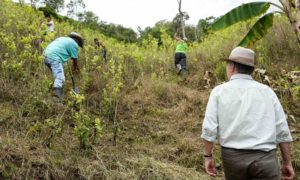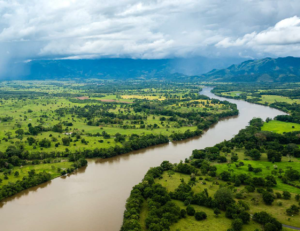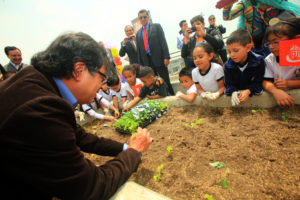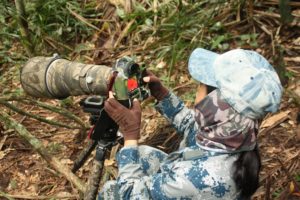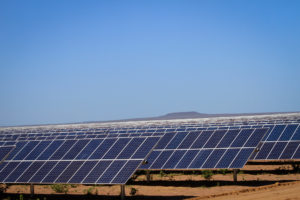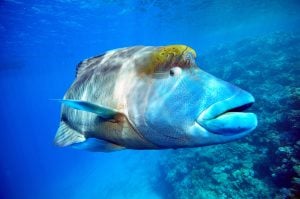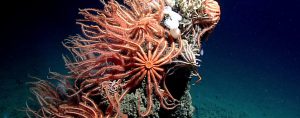Colombia wants to use glyphosate again on a large scale. This is despite the fact that, four years ago, it was one of the first countries in the world to restrict its use because of concerns about its effects on human health and the environment.
With the potent herbicide the subject of heated political debates and legal cases in Europe and the US, President Iván Duque wants to reintroduce glyphosate as his main weapon to fight illicit coca cultivation and the trafficking of cocaine, a derivative of the plant.
To do so, his government’s preferred chemical is a Chinese pesticide.
The political push for glyphosate
In much of the world, the debate over the use of glyphosate has centred on agribusiness and gardening. Yet, in Colombia the herbicide is synonymous with two decades of hardline anti-drug policies that aim to combat the lucrative business of cocaine trafficking.
For years, the Colombian government’s main strategy involved the aerial spraying of coca crops, which had political and economic backing from the US.
This was underpinned by the belief, seriously questioned today, that an anti-drug policy should focus on controlling the supply of drugs from producer countries such as Colombia, instead of focusing on tackling demand in richer, consumer countries.
For years, that meant that most of Colombia’s anti-drug budget went towards fumigating coca plantations with glyphosate, affecting mainly farmers and doing little to break the most profitable links in the cocaine trade.
The outlook changed in 2015, when the UN World Health Organisation (WHO) reclassified glyphosate as a “likely carcinogenic” substance. It did so after its scientific arm, the International Agency for Research on Cancer (IARC), determined that it can cause cancer of the lymphatic system (or non-Hodgkin’s lymphoma).
the fact that there are multiple indications of the effects of glyphosate on health and the environment must be sufficient for society to decide not to take the risk
The government of then President Juan Manuel Santos suspended aerial spraying as a preventive measure. Then in 2017, Colombia’s Constitutional Court ordered its suspension in a ruling that sought to protect an Afro-Colombian community from the remote Chocó region in the Pacific that had been affected by the fumigation,
Around the same time, Colombia adopted a different anti-coca strategy.
The 2016 peace agreement with the Revolutionary Armed Forces of Colombia (FARC), whose chapter on drugs was agreed in mid-2014, stated that the solution to illicit crop cultivation is to help the farmers. They needed viable alternatives in order to improve their living conditions, the agreement said.
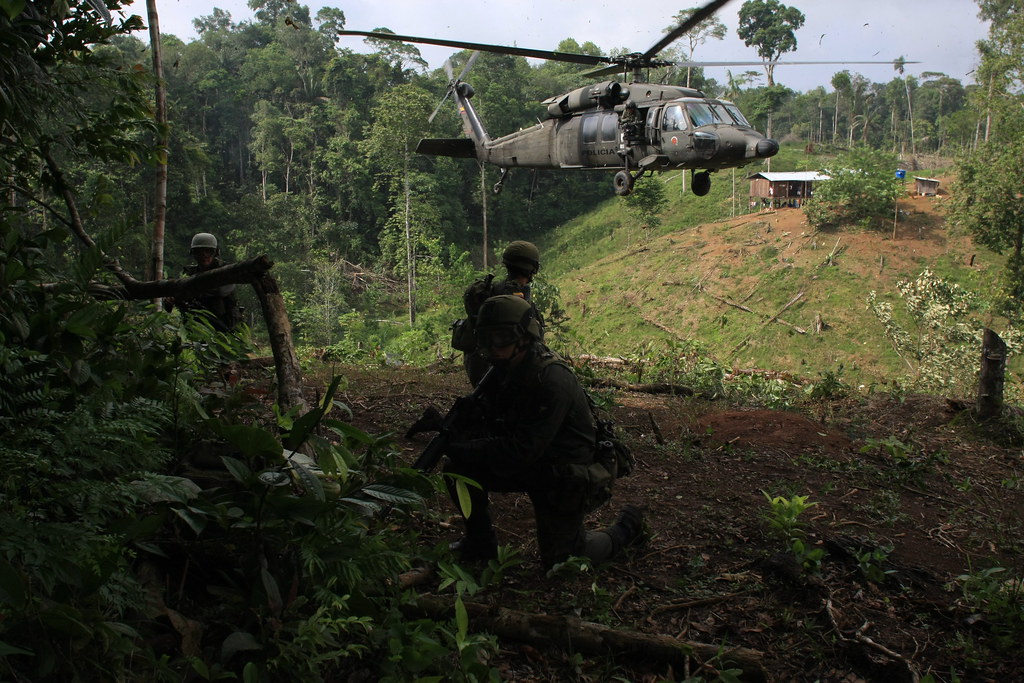
Under this premise, the government worked with communities to eradicate and replace coca, rather than confronting them. It would accompany them throughout the process, supporting them with access to veterinarians and agronomists, finding markets for their products and investing in public goods and services such as roads, health and education.
Spraying became a last resort for farmers who did not want to switch. This system allowed the army and police to concentrate on organised crime.
171,000
hectares were devoted to coca cultivation in Colombia 2017, a record high
However, the implementation of Santos’ substitution programme was slow and erratic and coca cultivation expanded to a record 171,000 hectares by the end of 2017, according to the UN’s Office on Drugs and Crime (UNODC).
Also under Santos, 2012 and 2013, had seen record low planted areas of coca, just 48,000 hectares.
The exponential increase in coca cultivation was politicised by influential former President Alvaro Uribe, who attacked the peace agreement signed by Santos, his former Defence Minister.
When Uribe’s protégé Ivan Duque won the presidency in 2018 on a platform opposing the peace deal, the pledge to fumigate coca reappeared.
The government asked the Constitutional Court to facilitate spraying, given the magnitude of the coca problem. A week ago, Colombia’s highest court laid out its conditions. Duque can move forward once he designs a programme that meets these requirements and once he has obtained an environmental licence.
Duque’s government has chosen a Chinese chemical company to reintroduce spraying. A month ago, anti-narcotics Police, which oversees fumigation, purchased 793 drums of the Chinese-made herbicide Cuspide 480 SL, according to local journalist María Jimena Duzán.
Meanwhile, other countries questioned glyphosate’s effects on human health and the environment.
In the US, three juries have handed down million-dollar convictions against Monsanto (now owned by German giant Bayer) in the past year. These cases ruled that users of glyphosate-based herbicide RoundUp had developed cancer.
Europe also witnessed an intense political debate over the substance, with nine countries, led by France, petitioning the European Commission not to renew the company’s license in 2017.
A moratorium was granted until 2022, but more tough discussions are expected. Last month, Austria became the first country to ban glyphosate. The European court of justice determined that citizens should have access to studies on the substance.
Chinese herbicide
Since the reintroduction of coca fumigations, Colombia has opted to buy Chinese chemicals whose safety has been questioned.
Colombian police previously sprayed coca crops with RoundUp. However, since 2011, it has swapped it for the cheaper, glyphosate-based pesticide, Cuspide 480 SL, which is made by several Chinese companies including Weifang Shandong Rainbow, Trustchem Co., Gilmore Marketing & Development Inc. and Qiaolang Company, according to Colombian environmental authorities.
this is an opportunity to have a frank discussion about the different tools to deal with the crops
The active ingredient of this formula is always glyphosate manufactured by Anhui Huaxing Chemical Industry, a privately-held Chinese agrochemical company listed on the Shanghai stock exchange, 60% of whose shares are held by the government-controlled State Commission for the Supervision and Management of State Assets.
In July 2012, glyphosate provoked a dispute between the US and Colombian governments. In a letter to Colombia’s Deputy Defence Minister Jorge Enrique Bedoya, the US Embassy’s top anti-drug official James B. Story announced that samples of the Chinese herbicide had not passed tests carried out by a Texas laboratory approved by its environmental authority.
“It is not viable for use (…) since it does not comply with the requirements of the Environmental Protection Agency (EPA)”, Story said, explaining that there were doubts about its effectiveness and volatility, owing to containing a corrosive and flammable substance prohibited in US pesticides.
However, there was an even more serious warning about the active ingredient nonylphenol ethoxylate. “It must be reiterated that this substance is banned by entities of the European Union and is restricted under Canadian, German and Danish regulations”, they warned.
Seven years later, it is not clear whether the problem was in the chemical itself or in the samples they tested given that the US claimed drums had signs of being relabelled. The only importer in Colombia – and the beneficiary of the most recent contract this year – is a small distributor called Talanú Chemical Ltda., based in the city of Ibagué, west of Bogotá.
Glyphosate fears
Although there are no studies that have irrefutably proven the health or environmental impacts of glyphosate, at the very least, it has not been a successful policy for eradicating coca. Efficiency and cost are the main problems.
$72,000
the total estimated cost in US dollars of eradicating one hectare of coca with glyphosate
Economist Daniel Mejía, who founded the Centre for the Study of Security and Drugs (CESED) at the University of The Andes, calculated that eradicating one hectare of coca requires the fumigation of 30 due to the high percentage of re-sowing. If fumigating a single hectare costs about US$2,600, guaranteeing its elimination would cost US$72,000.
In any case, it has a lower human cost than another strategy used in Colombia by the government. Forced manual eradication, undertaken by soldiers and policemen, has left 126 civilians and servicemen dead and 664 wounded, according to data by the Anti-Narcotics Police.
Other economic studies highlight impacts of aerial spraying on the health of local communities. Both Mejía and economist Adriana Camacho found that medical consultations increased during times of fumigation and that there is evidence of an increase in skin disorders and miscarriages.
Sandra Rozo, of the University of Southern California (USC), found that in heavily fumigated municipalities child labour and infant mortality rates rise not because of the glyphosate itself, but because of increased poverty levels in those communities. When crops fail, many families push underage children into work.
Fumigations also test the legitimacy of the government in communities’ eyes. In fumigated regions, distrust of the communities towards the military, police and, the whole state in general is higher, inhibiting institutions’ ability to establish a lasting positive presence, according to political scientist Miguel García Sánchez.
All this has led many experts to ask for a serious evaluation of whether aerial spraying is an ideal solution.
“We must have a debate based on what the scientific research suggests; the fact that there are multiple indications of the effects of glyphosate on health and the environment must be sufficient for society to decide not to take the risk,” says Ana Maria Arjona, a professor at Northwestern University and current Director of CESED.
Former Health Minister Alejandro Gaviria told the court: “If health is a fundamental right, the state cannot deliberately act against the health of the population…It is not an academic or technical debate, but rather an ethical debate.”
Other scholars are calling on Duque to consider the legal restrictions on fumigations.
For example, spraying is constitutionally prohibited in national parks, where 5% of the country’s coca is grown, due to possible environmental damage. It is also banned in areas inhabited by ethnic minorities, which account for 26%, and where spraying can only be carried out following a prior consultation process.
The court also ruled that fumigation should not be carried out in areas where the comprehensive crop substitution programme (PNIS) is currently in place.
Juan Carlos Garzón, from the Ideas for Peace Foundation (FIP), said:
“If we map the different layers of restrictions on glyphosate, we see that what remains to be sprayed is very small. Given this reality, this is an opportunity to have a frank discussion about the different tools to deal with the crops.”
